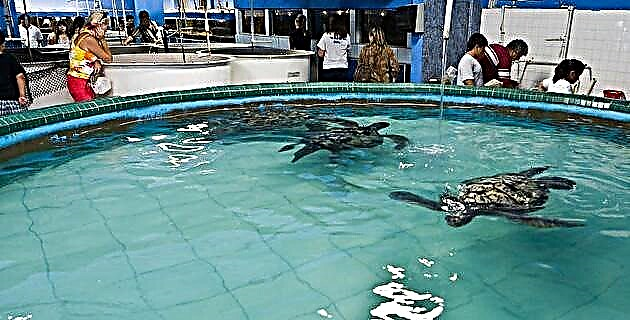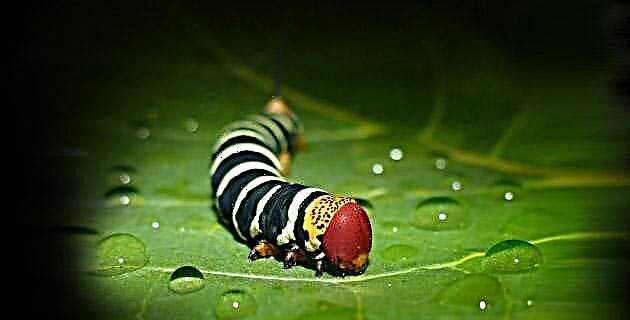
Grotesque in appearance due to their strange shapes, striking colors and a body adorned by extensions that form horns, tails and other appendages, they are caterpillars, unrelated in their physical configuration but vital in the reproductive cycle of butterflies.
The four stages that make up the life of a butterfly are a natural wonder: egg, caterpillar, chrysalis, and butterfly. From the egg stage a small caterpillar is born that only lives to grow and feed. Later, the tiny larva is released from its skin up to fifteen times, to produce a more flexible one and grow and become a chrysalis; Once inside it, the caterpillar changes its shape completely and does not grow any more.
Caterpillars, like all insects, have a head, abdomen and thorax with six legs, each one ending in a curved and sharp pincer. They use their legs to walk and hold their food; on the other hand, its pairs of “false legs”, thicker than the real ones, and a crown of crochets, are useful for holding onto leaves and branches. Its body, divided into rings, has segments in three regions; cephalic, with a single ring; thoracic, with three parts, and the abdomen, composed of nine parts. The three anterior segments have legs, called "true" because they are the ones that will remain in the adult; These clamping appendages intervene in the advance of the caterpillar and help it to hold its food; the others are membranous and disappear with metamorphosis.
Almost all of them are known as worms and it is easy to observe them in fruits, plants and in the soil. Most are elongated with or without extensions, some look like slugs, other mealybugs and many more have abundant hairs. The abdomen contains the muscles, the heart, the vital fluid and the stomach; It is the widest part of the body and the one that facilitates movement; Its eight spiracles or holes on each side serve for breathing. The skin is smooth in some species, others have short, fine hair and long hairs, sometimes with sharp spines that can be stinging and that remain toxic even after being separated from the body. The caterpillar lacks compound eyes, although instead it has six ocelli on each side with which it does not distinguish colors, but shapes and movements. Nearby is the mouth, in its lower front portion, formed by two strong jaws adapted for chewing.
The body of the caterpillar, made up of numerous rings, allows it to grow and enlarge when eating its food. His skin is not elastic, when it is small he must molt it, up to seventeen times throughout his life, depending on the species, and only in this single period does he stop eating. When the caterpillar is plump it changes its activity and wanders from one place to another, sometimes quite far from the host plant, as it looks for a safe place to settle and transform into a pupa or chrysalis. It is in this last molt when many are enclosed in a silk cocoon woven with a buccal device and its siliceous glands; the cocoon that surrounds the pupa maintains moisture and protects it from predators. Others, from youngsters, wrap themselves in silk, such as gregarious ones that occupy nests to protect themselves from the environment; and still others join several sheets with silk threads.
LIVE ONLY TO EAT
In the beginning, the female butterfly is very far-sighted and always chooses a nutritious plant to lay her eggs in, because most caterpillars can only eat one or two plant species; thus, the larvae at birth will have food nearby and will begin to eat quickly. The first activity of the newborn consists of devouring the shell of the egg to enlarge the hole and be able to come out; In this way it gains strength to search for food, because during all the months of its life the caterpillar only accumulates reserves and eats leaves, tender shoots, fruits, flowers, wood, skins, woolen fabrics, remains of its eggs and even its congeners. . Most caterpillars live alone on the unique food plant for each species, only some can eat several plants.
Unlike the butterfly, the caterpillar is always a chewer, it is well equipped and its cleft mouth allows it to devour the leaves by the edge, with a pair of strong jaws and jaws assisting in chewing. Its enormous voracity can turn it into a pest that quickly devastates leaves, crops and gardens, although there are few species with this destructive power. After eating, they usually hide on the underside of leaves, in the bark of logs, under stones, or take refuge in the ground. Those that live in groups are small in size and become independent when they reach maturity, while others are social throughout their lives. Biologists have observed that this temporary society is due to the fact that in their childhood they are exposed to the attack of birds and other enemies; the danger diminishes as they grow, as their larger appendages make them look terrible, acquire toxicity and unpleasant taste, or become confused with their environment.
The danger is constant for the plump caterpillars, because birds, lizards, frogs, spiders, wasps and many other animals, can be deadly enemies. Although birds are the most frequently cited, they are not the biggest killers, since arachnids and coleopterans cause them serious damage, especially endoparasitic insects and certain bacteria. Some insects lay their eggs inside the caterpillar and let it live in the wild, others paralyze it and take it to their hiding place to keep their body fresh as food for their larvae, and many more caterpillars are infected by epidermal fungi.
SUBTLE DEFENSE STRATEGIES
Caterpillars become appetizing larvae that do not want to be eaten, and for this they use different strategies. When hatching they must defend themselves: some feed under the cover of night and hide during the day, and others sport large fake eyes on the upper part of the body to create a horrible appearance and scare off potential predators. As they cannot run to escape their enemies, they have adopted different forms of defense: they emit repellent odors, they launch liquid formic acid or they present horns bathed in foul substances. Stinging hair-covered caterpillars are common, such as the so-called “scourgers” of central Mexico.
They practice all the techniques of camouflage: the species that live in the leaves have green tones, and those that frequent branches or trunks are brown; others are born with a color and change as they grow.
However, their best adaptation to avoid being discovered is to be very discreet and remain immobile to go unnoticed. They depend on mimicry to survive, they deceive their enemies with costumes that make them look different, they look like leaves, seeds, stems, thorns and even bird droppings, like the caterpillars of the large Papilio butterflies. Those that are protected by mimetic characters are not hidden, or they do so partially: some have drawings that "break" the line of the body to better camouflage themselves, and there are those that disguise themselves to look like tree bark, garbage or twigs, generally little desirable as food.
In addition to mimetic resources, caterpillars have other defensive elements, such as odoriferous organs and external protuberances that scare away the enemy, as do moth caterpillars, which are provided with long, feathery dorsal or lateral appendages, which are sometimes so many and so big that they make them real monsters. Some, like the monarch, feed on plants with toxic properties that do not harm them, but do make them taste bad; thus, the birds that eat them suffer annoying pain and soon learn to respect them. Many bad-tasting caterpillars are inconspicuous and display bold hues, called “warning colors,” that keep the enemy away; it is a way of showing that they taste bad or that they are toxic. Others, in the face of danger, let themselves fall, remaining hanging by a thread, to later climb back to their refuge.
Caterpillars live in constant danger: they are food for many animals and therefore must find enough food to gather energy, guard against predators and survive inclement weather; however, in recent years, in all their phases they are victims of various artificial poisons, which has seriously affected their populations.
In the beneficial aspect, eggs, caterpillars, pupae and butterflies represent an irreplaceable source of food for wildlife. On the other hand, they also fulfill the ecological function of balancing their natural environment, because in turn they devour other caterpillars, aphids, aphids, crickets, ants and small insects, which become harmful or become pests.
WONDERFUL TRANSFORMATION
The caterpillar lives for several months, with exceptions in which its longevity exceeds one year; for this it needs to shed its skin as many times as its development requires, and to the extent that food is abundant, it can become a chrysalis faster. The first signs of this imminent change are absolute fasting, which allows you to cleanse your stomach; at the same time, with great restlessness he wanders from one place to another, until he finds a suitable place to adhere and carry out the transformation. Then, inside the cocoon, the discreet change continues. One day, finally, it peeks out and out, now turned into a beautiful butterfly: an important insect in the fabric of life for more than 50 million years.
In spite of everything, today wildlife is in danger and we know that when an animal or a plant goes extinct it is forever. The habitat is disturbed by pollutants, fires, crops, toxic products, buildings, and human demographics. We must prevent species of caterpillars and butterflies from disappearing, because since the beginning of time they have been admired for their fragile flight and beauty, and they have been part of the culture, art and sciences of countless peoples, who have sculpted them, painted and included in stories, poetry and dances. The butterfly is a marvel that adds visual beauty and mystery to our world, and its metamorphosis has been a life-changing symbol throughout human history.
Source: Unknown Mexico No. 276 / February 2000











